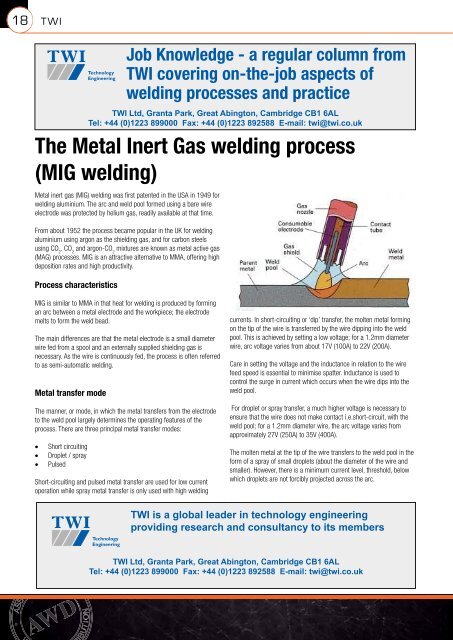rld
Create successful ePaper yourself
Turn your PDF publications into a flip-book with our unique Google optimized e-Paper software.
18<br />
TWI<br />
TWI<br />
<br />
<br />
Job Knowledge - a regular column from<br />
TWI covering on-the-job aspects of<br />
welding processes and practice <br />
<br />
<br />
<br />
<br />
<br />
<br />
<br />
The Metal Inert Gas welding process<br />
( (MIG (<br />
welding)<br />
Metal inert gas (MIG) welding was first patented in the USA in 1949 for<br />
welding aluminium. The arc and weld pool formed using a bare wire<br />
electrode was protected by helium gas, readily available at that time.<br />
From about 1952 the process became popular in the UK for welding<br />
aluminium using argon as the shielding gas, and for carbon steels<br />
using CO 2 . CO 2 and argon-CO 2 mixtures are known as metal active gas<br />
(MAG) processes. MIG is an attractive alternative to MMA, offering high<br />
deposition rates and high productivity.<br />
Process characteristics<br />
MIG is similar to MMA in that heat for welding is produced by forming<br />
an arc between a metal electrode and the workpiece; the electrode<br />
melts to form the weld bead.<br />
The main differences are that the metal electrode is a small diameter<br />
wire fed from a spool and an externally supplied shielding gas is<br />
necessary. As the wire is continuously fed, the process is often referred<br />
to as semi-automatic welding.<br />
Metal transfer mode<br />
The manner, or mode, in which the metal transfers from the electrode<br />
to the weld pool largely determines the operating features of the<br />
process. There are three principal metal transfer modes:<br />
<br />
Short<br />
<br />
circuiting<br />
Droplet<br />
<br />
/ spray<br />
Pulsed<br />
<br />
<br />
Short-circuiting and pulsed metal transfer are used for low current<br />
operation while spray metal transfer is only used with high welding<br />
TWI<br />
<br />
<br />
currents. In short-circuiting or ‘dip’ transfer, the molten metal forming<br />
on the tip of the wire is transferred by the wire dipping into the weld<br />
pool. This is achieved by setting a low voltage; for a 1.2mm diameter<br />
wire, arc voltage varies from about 17V (100A) to 22V (200A).<br />
Care in setting the voltage and the inductance in relation to the wire<br />
feed speed is essential to minimise spatter. Inductance is used to<br />
control the surge in current which occurs when the wire dips into the<br />
weld pool.<br />
For droplet or spray transfer, a much higher voltage is necessary to<br />
ensure that the wire does not make contact i.e.short-circuit, with the<br />
weld pool; for a 1.2mm diameter wire, the arc voltage varies from<br />
approximately 27V (250A) to 35V (400A).<br />
The molten metal at the tip of the wire transfers to the weld pool in the<br />
form of a spray of small droplets (about the diameter of the wire and<br />
smaller). However, there is a minimum current level, threshold, below<br />
which droplets are not forcibly projected across the arc.



